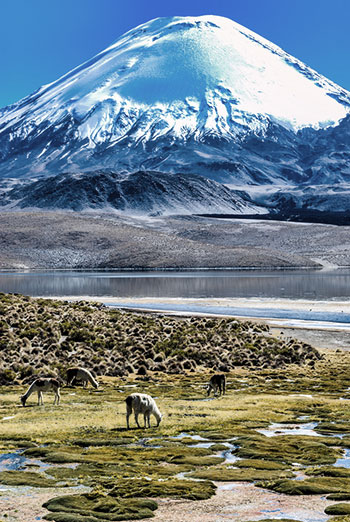Poems by Carla Rojas Paz
Archives: by Issue | by Author Name

Saving Home
by Carla Rojas Paz
From Canary Spring 2025
Carla lives east of the Gulf of Mexico near a large and beautiful natural harbor and shallow estuary and on the traditional lands of the Seminoles.

FIRE: Canada
1.
Amy looks out over the tree line in the boreal forest, where a raging inferno of orange roars above the pointed jack pine trees. Plumes of black smoke grow above it like tumors, fading into haze while hazardous particles blow into the United States and travel across the Atlantic. She pours water on her face. It drips down onto her heavy firefighter uniform, leaving streaks of soot, sweat, and dirt.
Amy knows fire. It’s her culture. It’s healing. For centuries, her people of the Métis
Nation, like many other indigenous groups worldwide, practiced “cultural burns” or
controlled low-intensity fires rooted in intergenerational knowledge to regenerate the
forest’s soil nutrients and reduce tinder-dry bush that fuels wildfires like the one she’s
fighting, but the government banned them up until last year. First, they displaced her
people from the land—their home; then came the ban.
Before jumping into her truck, she takes a few minutes to mourn her family’s pictures and heirlooms that she couldn’t save as she evacuated her house. They vanished in ash. Amy prays over her ancestral land and the wind carries the prayer far east, where it settles on a house of sand in Somalia.
2.
AIR: Somalia
“Allah is angry at us,” says Muna, as she scoops buckets of white sand out of her
living room on Somalia’s coastline. “Keep shoveling,” she instructs her four children.
And they shovel, just like they have for almost a year now. The youngest, a one-year-old,
playing with a wooden spoon, grabs a fistful of sand and puts it in his mouth.
Muna thinks of Sharif, her late husband, and the first house he built for her that the sand
swallowed. Over the last three years, fierce winds have whistled and howled, gradually leveling trees, clogging water wells, burying houses, and entombing the town’s only school.
Muna and Sharif once owned hundreds of sheep and goats, which they used to herd in search of pasture and water. But the rains have not come again, and Muna owns only five sheep now. It’s not enough to provide for her family.
She stands in ankle-deep sand, observing the house’s rusty corrugated metal roof. It
rattles and creaks. Mogadishu, that’s where she’ll go next, like the rest of the families in
her town who left long ago, their houses succumbing to insidious sandstorms and
desertification.
Muna tosses the last bucket of sand. She looks out onto the ocean, and dreams of the soft waves caressing her lightly like Sharif once did. The tide has come. It pulls her memories along the waves and out to sea, until they reach the Pacific shores of Tuvalu.
3.
WATER: Tuvalu
Tala dives into the sparkling, shallow blue waters surrounding her home in Tuvalu.
She imagines she’s a bright blue surgeonfish, oval-shaped and smattered in dark blue body accents and a yellow tail, swimming, grazing on algae attached to coral. But in real life, as she swims closer, she sees only a ghastly white and gray graveyard of coral that looks like moldy and calcified sponges, brittle enough to break with a tap of a finger. She sees no fish. They’ve left their once-fertile feeding grounds, now a hot and acidic soup of an ocean.
Tala emerges from the water on the beachfront, where her brother is piling old rubber
car tires under the coconut trees in the front yard. It’s a makeshift seawall to temporarily stop the rising sea waters from reaching her house.
“The foreign minister just called for Tuvalu to become the first digital nation in the
Metaverse,” her brother says.
“What?” says Tala.
“We’re sinking under water, and everyone is leaving for Australia or New Zealand,” he
says. “He thinks Tuvalu can keep existing, either in virtual or augmented reality, so that
our culture can stay alive for future generations.”
A digital nation? A digital home? Tula contemplates this idea on and off for the next
couple of hours. Before she knows it, she’s lost track of time and the sun is setting. She
sits down on the beach and follows the sun’s gradual descent, letting it and her thoughts
submerge beneath the horizon. She’ll be asleep and dreaming of the ocean when the sun reappears, its reflection dancing off the glaciers in the Andes Mountains in Chile.
4.
EARTH: Chile
Kayla crouches awkwardly, facedown with her nose almost touching the ice of the
Southern Patagonian Ice Field in Chile. Her pupils dilate with wonder. She’s looking at
the rare “ice dragon,” a type of stonefly over half an inch long, that’s made a home out of
one of the most inhospitable, frigid, and barren mountains on earth. It skitters away.
As a little girl growing up on the Gulf of Mexico shores in Florida, Kayla thought she’d
become a marine biologist like her father, but the serene beauty of the ice-capped Andes
Mountains mesmerized her like magic. Twenty years ago she left Florida and made
Chile her new home.
“All good on the ice? Over,” says Kayla’s glaciologist friend on the satellite radio.
“No rumbles. Over and out,” says Kayla, referring to the sound of an avalanche. Six months ago, a jagged chunk of melting glacier crashed near tourists in the Queulat National Park. Patagonian icefields are among the fastest melting glaciers in the world.
Today is Kayla’s last day on the mountain before she takes a career break to care for her
ailing father in Florida. She crouches down toward the earth again and wonders how
much time her father has and what will happen to the ice dragon if its home keeps
melting.
Suddenly, she feels a cracking coming from her chest. Then a deep bass sound roars out
like a torrential waterfall. Startled, Kayla reaches for help on the satellite radio. But it’s
not an avalanche. The sound, alive and breathing, is grief for her father and for the
majestic and sublime place some call “The end of the world.” For Kayla, it’s home.
© Carla Rojas Paz